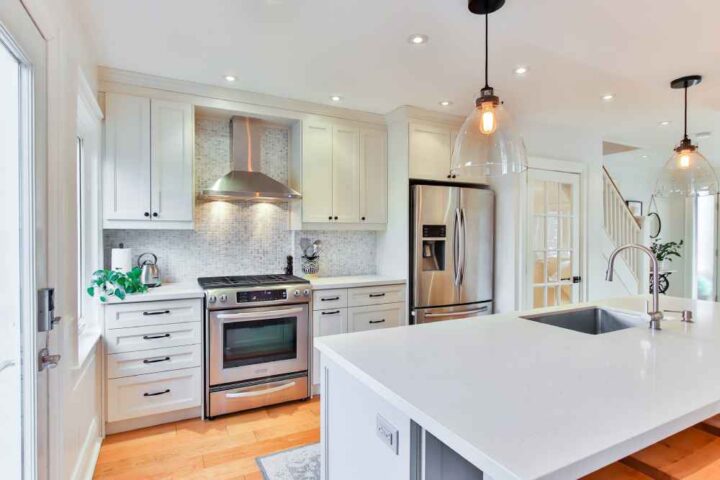Efficient Kitchen Design: Harnessing Style and Functionality for the Modern Home
Key Takeaways:
- Efficient kitchen design combines both aesthetic appeal and practical sufficiency.
- Selecting the right materials and technology can significantly enhance kitchen functionality.
- Sustainability and smart design are not mutually exclusive but can complement each other in modern kitchen renovations.
The kitchen, often referred to as the heart of the home, has transcended its traditional role as merely a place to prepare meals. It’s evolved into a multifunctional space that embodies the style and spirit of the homeowners.
Today’s kitchen designs are a blend of aesthetic allure and operational practicality. Moreover, they encompass personalized features that cater to individual preferences and lifestyle demands. If you are curious about creating such a space, considering an upgrade your kitchen with professional renovations in Toronto might be the first step towards this transformation.
Efficiently designed kitchens consider numerous factors, from spatial dynamics to material resilience and the integration of smart technology into sustainable practices. This guide aims to walk you through these diverse considerations, ensuring your kitchen is visually arresting and a paragon of functionality.

Planning Your Kitchen Layout
When formulating your kitchen’s floor plan, the aim is to create an area that promotes efficient food preparation and encourages comfortable social interaction. The concept of the kitchen work triangle, which organizes the placement of the refrigerator, stove, and sink into a triangular layout, is a time-tested strategy that reduces unnecessary movement.
Modern developments and designs, however, have expanded beyond this traditional model, introducing island counters and open-plan kitchens that merge seamlessly with living areas. This evolution broadens the scope of a kitchen, making layout planning a pivotal step in kitchen design.
Selecting the Right Materials
Your choice of materials directly affects the longevity and environment of your kitchen. On the one hand, countertops require durability to withstand daily wear and tear, necessitating materials like natural stone or modern composites. On the other hand, cabinets offer a canvas to express personal style – whether through the warm tones of natural wood or the sleek finish of laminates.
Even the kitchen floor must marry durability with style; ceramic tiles and hardwood floors tell a different story. Understanding these materials’ properties and how they interact with each other within your space is key to creating a cohesive kitchen design.
Incorporating Smart Technologies
The integration of technology in kitchen design can streamline cooking processes and make management tasks much simpler. Smart refrigerators can now track your groceries, while ovens precision-cook based on online recipes.
The advantages are clear, from bespoke storage solutions that maximize space to voice-activated faucets that deliver hands-free convenience. Not to be overlooked are the central roles that technology can play in entertainment through integrated sound systems and smart lighting capable of creating ambiance at a command.
Sustainability in Kitchen Renovations
Renovating with an eco-centric approach has never been more pertinent. Today, making sustainable choices can influence everything from water usage with low-flow fixtures to energy consumption through star-rated appliances.
Moreover, materials sourced from eco-conscious suppliers ensure that your kitchen’s environmental impact is minimized. Incorporating these elements supports global sustainability efforts and can lead to cost savings in the long run—a win-win scenario eloquently outlined by the Environmental Protection Agency’s thoughts.
Lighting and Its Impact on Kitchen Design
Neglecting proper lighting can impair the beauty and functionality of your kitchen. An effectively lit kitchen comprises a layered approach that blends task lighting for preparation areas, ambient lighting for general illumination, and accent lighting to highlight design features. The evolution of lighting technology has brought solutions like dimmable LED lights, which offer longevity and energy efficiency. The right lighting facilitates kitchen tasks and sets the mood, making the kitchen inviting for family and friends.
Maximizing Storage Space
Kitchens can quickly feel cramped without sufficient storage. Modern storage innovations leverage every square inch with tiered drawers, corner cabinets, and pull-out pantries. Even the often-overlooked spaces, like under the sink or above the fridge, can be transformed into useful storage areas with the right design. Smart storage solutions keep the countertops clear and the kitchen organized, thus creating a more pleasurable cooking and socializing space.
The Charm of Personalization
While efficiency is important, the personal touches turn a kitchen from a mere room into the heart of your home. From selecting a custom tile mosaic backsplash to choosing unique cabinet handles or a statement piece of lighting, these individualized elements inject character into the space. Personalizing your kitchen allows you to enjoy a space that reflects your taste and caters to your functional preferences and culinary habits.
The Importance of Aesthetics in Kitchen Renovations
It’s crucial to balance aesthetics and utility in your kitchen. An attractive layout and design create an atmosphere that homeowners and guests enjoy while providing the practical benefits of a functional workspace. A thoughtful choice of color schemes, textures, and finishes can all contribute to the overall feeling of your kitchen. It’s about finding a focal point—perhaps a striking light fixture or a unique countertop—that anchors the space visually and pulls all the other elements together.
Final Considerations Before Starting Your Renovation
Embarking on a kitchen renovation is no minor endeavor. Much like preparing a gourmet meal, it requires careful planning, precise timing, and a touch of finesse. Establishing a realistic budget and timeline is essential to avoiding unnecessary stress and ensuring the project moves smoothly from vision to reality. Choosing the right professionals to guide and execute your vision is equally vital. Considering these factors, alongside preparation for the temporary disruption, will pave the way for a successful kitchen transformation.


